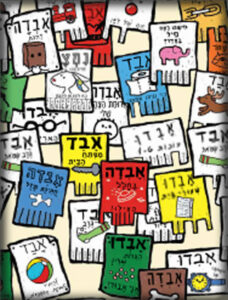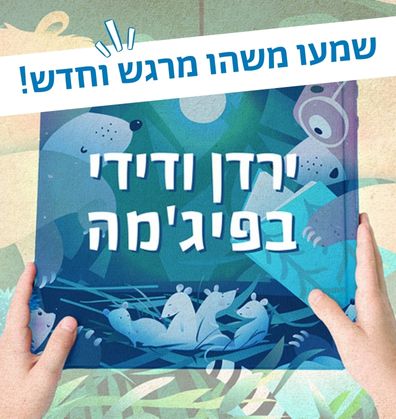כִּשּׁוּרֵי חַיִּים
עזרה לזולת
טיפוח ערך העזרה לזולת מוביל אותנו לפתח קשרים טובים יותר עם הסביבה ועם הקהילה, ומעצים את תחושת המשמעות, הסיפוק והשייכות. סיפורים על עזרה לזולת, פותחים דלת להבנה חברתית, להתחשבות באחרים ולנתינה המרחיבה את הלב.
סְּפָרִים
Book-Related Family Activities

Family reading advice
A demonstration of the characters enhances the reading experience, peaks toddlers’ curiosity, and helps them focus on the story. You can add a suitable voice or hand gesture for each character, and repeat it each time it appears, for instance: arm-flailing to denote the bird, feelers to denote the ladybug, or making a fist to denote the snail’s shell.
Rinat Hoffer illustrated and wrote many Israeli children’s classics, including Hannan the Gardener [Hanan HaGanan] and Cloud on a Stick [Anan Al Makel]. Her unique amusing style perfectly incorporates rich language, imaginativeness, and rhymes into her texts and illustrations. For her prolific work, Hoffer has won many awards.

Encountering animals on our day out
You can discuss the animals you encounter on your way home, on trips, or in your general vicinity. Have you encountered one of the animals mentioned in the book? What other animals have you encountered? Where does each of these animals live?
QR code
Ayelet’s Day Out features on Didi and Yarden’s Sifriyat Pijama podcast too. Scan the code and enjoy listening to

Illustrated clues
The appearance of each animal in the book is preceded by textual and Illustrated clues. Try to guess which animal is about to appear at each stage. You can also play a guessing game – each family member in turn can mimic one of the animals in the book using voices and movements, while the other players try to guess which one it is.
A day out at home
You can take animals of various sizes, and try to carry them all just like Ayelet while taking a walk around the house. Which one fits in your pocket? Which one can stand on your head? Perhaps you can find some other way that Ayelet has not tried yet.
A piece of advice when reading to toddlers
We recommend reading the book alone first, before reading it as a family. Prior familiarity with the book helps to read it seamlessly later, at a pace suitable for toddlers. Enjoy reading this book!
A discussion on who can help
We can all help others, even toddlers. You may want to ask your toddlers how they can help others, or tell them that they are helping when it happens: “Remember when you helped me set the table?” “Look at you helping me put away the toys!”
Listening to the story
Would you like to listen to the book Noni and his Mom Walk Homefrom Kindergarten? Please scan the QR code to find a recording of this book. You could listen to it while traveling, playing, or sitting together while turning the pages of the book.
A story in illustrations
The illustrations are part of the story, and using them, toddlers identify and recognize the plot and some of its details. You may enjoy looking at the illustrations together, and searching for the items that Nomi gives his mother: ‘Where do you see an illustration of a bag?’ and ‘Where can you find an illustration of a coat?’
Playing a game of ‘An items tower’
Inspired by the items piling on top of mom in this book, you may want to take turns building a tower out of various items: Very carefully, one on top of the other, you can place building blocks, toys, hats, bags, and anything else you might want to add.
A discussion on fear and encouragement
As our children grow up, they experience various fears, but discussing them helps them to cope with them, while instilling in them a sense of security. Together you can choose to discuss what they find scary, and what helps them overcome their fears.
Listening to a story
Would you like to hear Maayan and listen to everyone cheering her on? Scan the code and listen to the story together.
הַסִּפּוּר לְהַאֲזָנָה – עַכְשָׁו בָּפּוֹדְקַאסְט שֶׁל סִפְרִיַּת פִּיגָ’מָה!
בגן At the playground
After reading this book, you may enjoy going to the playground together, and trying out the equipment together as well as separately. Perhaps you would like to invent a special course from the slide to the swing and so on that would bring joy to all of you.
Family encouragement
“Hooray, Maayan!” Everyone calls out when Maayan is scared. How do you cheer one another on? Perhaps you could come up with family words of encouragement, find a motivating song, or a chant you all agree on that cheers you up and gives you strength.
A discussion on what has been lost
Have you ever lost anything you found important? How did you feel and what did you do? Perhaps you’ve found someone else’s lost item… This book invites children as well as parents to share their childhood experiences of losing and finding lost items.
A video about a lost and found stand
A video about a lost and found stand
Shabi and Uzza from the Israeli children’s television show Parpar Nechmad are also returning lost items to their owners. Scan the code to watch the video.
We can help too!
What can toddlers do at home? Many things! They can put glasses on the dining table, sweep with a small broom, feed the pets, and… offer cookies. It is worthwhile to talk and show what the toddler is helping with at home, and what else they want and can participate in.
Who is in the family?
The child in the story hands out cookies to other family members: grandmother, uncle, sister, cousin. Who are your family members? You can talk about family members, say their names and thier roles, such as: “Grandma Braha,” “Uncle Baruch,” use family photo, and use family photos.
Let’s make some refreshments together!
You too can prepare refreshments together, such as chocolate balls, a plate of fruit, or a sliced cucumber. You can prepare “pretend” refreshments using play dough and offer to the dolls at home.
Game: Grandma had cookies…
Do you know the game “Grandma made porridge”? “The child had cookies” can be played in a similar way, in which the toddler opens her, or his hand, and the parent begins to count: “The little boy/girl had cookies and gave one to Grandma (holding the thumb), and one to Uncle (holding the forefinger) etc. And so you count the fingers by allocating a family member to each one. Who will you give the last cookie to?
Discussion – A story worth gold
The brave stork’s reward was… a story worth gold. Do you have such a family story? You could tell it to your children, and search for other family stories by asking your grandparents and other family members.
What did the stork say?
Imagine you were the stork – what would your thoughts be? What would you have said to the lion, and how would you have told the story? Try to tell it from the stork’s perspective. You may also enjoy drawing the story, or making costumes with which to act the story out. How about taking photos of your short play, and printing them out to create a book worth gold.
Brave as a stork or hardworking as an ant?
Animals in fables have human characteristics: the stork is brave, the lion is strong, and the ant is hardworking. Which animal best symbolizes you? Try to think and discover which animal is most similar to you, and write down sentences that characterize you, such as: “I’m as smart as a …”, “I solve problems like a …”, or “I love singing like a …”
A feast
Is the meal prepared by the lion appetizing? It’s time for a feast. You may want to prepare your family’s favorite food, draw animal characters on paper napkins, make a crown for each person sitting at the table, and eat together.
Suggested Family Activities
- You can flip through the illustrations with your children and identify the work that the brothers do together. In every home there are tasks that invite collaboration. Which household chores are easier and more pleasant to carry out together?
- There are many verbs that describe the work of the farmer. Do your children know them? You can act out the different actions using pantomime.
- Each of the brothers considers the other’s needs and gives up his share without being asked. Together with your children, you can make an illustrated list of examples where members of your family share and are considerate to one another.
- Like the brothers in the story, you too can prepare a surprise for your children in the middle of the night. Following your example, your children may surprise you too!
- The brothers in the story understand that fair does not always mean equal. How true this is in family life as well! You can demonstrate this principle using clothes: Gather up different pieces of clothing belonging to the members of the family and ask your children to sort them. Would it be fair to give Mommy’s blouse to a child, or Daddy’s slacks to a baby? This can lead into a discussion of the needs of members of your family, and to your assurance that their needs are met, even if they don’t always get exactly the same thing as their siblings.
- “Everyone has a city named Jerusalem” (Natan Yonatan): After reading together the tale of the Temple, you can show your children pictures of Jerusalem (or visit!), sing songs about Jerusalem, and relay to your children stories about “your Jerusalem”.
Family Activities
Colored words are woven into the text of the story. Show your child the colored words and try to guess why the designer chose these colors. Who do the pink words describe? Which colors depict the words for “cake” and “strawberries”? Ask your child to help “read” the story with you by joining in with the colored words that they can identify.
“How good and pleasant it is for brethren to dwell together” – Sometimes, sitting alongside strangers (on the bus, at the playground, on line at the supermarket) can turn into a pleasant example of “brethren dwelling together”. You can think back to situations when you met new people in such a setting, who helped you pass the time. For instance, perhaps someone helped you lower the stroller down a flight of stairs or offered your child a snack while waiting for the doctor. Perhaps there were children who shared the swings at the playground. All these help illustrate the positive side of “brethren dwelling together”.
The two grandmothers both love Avigail. You might suggest that your child draw a picture of Avigail, surrounded by all those who love her. They can then draw a picture of themselves and all those who love them!
Tsila and Gila’s car goes through tunnels and over bridges. Together with your child, you can create a make-believe track for the car within your home, “set out for your journey” and stop to pick up passengers along the side of the road who need help. Remember: In Tsila and Gila’s car, only the cake is not fastened in with a seat belt. Be sure all your passengers are strapped in when riding in the car!
Does your child like to travel? Ask your child about journeys he or she has taken, real or imagined: Where did they go, who joined them, what happened along the way? We invite you to send your stories and drawings to the Sifriyat Pijama website: www.pjisrael.org.
Did you ever set out for a journey, get lost, and find yourselves in a new and surprising place? This is a good opportunity to tell your children about your adventure. Be sure to describe about any disappointment or frustration your felt when you lost your way, and then the positive experience you had at the end.
“This too is for the best”: A sudden halt brings an end to the comfortable trip. All the drivers and passengers are disappointed with the traffic jam. If you go through the book, you can discover unpleasant situations that turned into happy occurrences.
Not everyone likes changes in plans. Do you have a special way to help yourselves and your child to accept changes? “Chutes and Ladders” is a board game in which surprises can cause set-backs (when going down a chute), but also be pleasing (when climbing up a ladder). You can create your own game “On the way to the birthday party”, along the lines of Chutes and Ladders. The chutes will appear whenever there is a delay in the journey, and the ladders will represent the happy surprises on the way.
One way to provide encouragement when things doing go as expected is to make a “This Too Is For The Best” sign. You can write the proverb and invite your child to decorate it. Be sure to hang the sign in a visible spot in the house, to remind you that even unexpected things can turn out for the best.
The cute puppy found a welcoming home, and Avigail received a perky gift for her birthday! You can make finger puppets of Avigail and the dog: Draw or copy the characters from the book onto a piece of paper, and attach them to your fingers by stapling together the edges of the reverse side of the paper. The puppy can share his adventures in the car with Avigail, and she can tell him how she passed the time while waiting for her grandmothers to arrive.
All’s well that ends well: The granddaughter and her two grandmothers celebrate her birthday with tea and cake (and the puppy enjoys himself too, in his own way). You too can make a small tea party and invite over friends who want to share in experiencing “how good and pleasant it is for brethren to dwell together”. Be sure to sing together in Hebrew “Hineh ma tov u-ma na’im shevet achim gam yachad”.
Family Activities
- Have your children “read” the pictures and tell you the story, using the illustrations as their guide. You could pay particular attention to Moses’ facial expressions, and ask your children why they think he didn’t give up on one little kid, despite the fact that he had an entire large flock with plenty of goats?
- Even young children can be “big” and responsible! Help your children recall occasions when they were helpful to other children or small animals. Point out that even small, seemingly unimportant acts of kindness can be very meaningful for those in need; they also serve as a personal example for the entire “flock.” Afterwards, you could draw a picture together depicting one of the times when your children helped others.
- The story of Moses and the kid takes place in a desert. Are your children familiar with desert life – the different kinds of flora and fauna, the wells and oases, etc.? Have you ever visited a desert? Or perhaps you live in a desert area? You might go on a field trip, and compare the climate and scenery on your trip to that in the story.
- Look for the illustration that shows Moses carrying the little kid on his shoulders. Ask your children if they ever felt so tired that they asked to be picked up. Children often ask to be carried, even after they are big enough to walk on their own. You could discuss the times you carried them and the times they were able to walk independently. You could play piggy-back around the house, pretending to be Moses with the little kid.
- Many of our leaders started out as shepherds. Discuss the work that a shepherd does, and the qualities that go into making a shepherd. You could think together about how working as a shepherd helped Moses, when the time came, to lead the Israelites in the wilderness. Try to recall other shepherd-leaders in Jewish tradition (for example, King David and Rabbi Akiva).
- Moses struggles to catch up with the fleet-footed little kid. You could play “catch” together. First, you might play the role of Moses and call to the kid, “Little kid, stop. Little kid, come back!” while your children play the kid that “runs faster and faster.” Then switch roles. Who ran faster – you, or your children?
- What other stories and tales about Moses do your children know? After reading this book, you could tell the story of the Exodus from Egypt and the Israelites’ wanderings in the wilderness, and talk about the figure of Moses.
Family Activity
- Bear’s friends try to cheer him up and make him happy. Each one of them does their best. But how do they do it? Pick one animal and focus on its actions throughout the book. What kind of help does this animal give Bear?
- Have you ever visited a sick friend or relative? Did anyone ever visit you when you were not feeling well? How can we cheer up our kindergarten friends when they are sick?
- The badger gives Bear a herbal tea to drink, made from the medicinal herbs picked by Bear’s friends. You can also make a delicious, warm, herbal tea for your family: Put some herbs like mint (nana), rosemary, lemon verbena, or sage in a teapot. Add four cups of hot water and some honey. Pour a cup of tea for every family member and decorate it with a lemon slice.
- Play “make believe sick”: practice the mitzvah of visiting the sick with your family. Let your child take care of you and help you relax. Tell them what helps you when you’re not feeling well. This is a golden opportunity to remind your children that they have the power to heal others!
- At the end of the story, Bear gets better, and finds out that the friends who helped him recover are all sick! How does Bear “know” to take care of his friends, and how does he manage to take care of so many friends at once? Using stuffed animals or dolls, make a small play showing how Bear takes care of his friends.
“You must exercise great caution concerning your lives” Venishmartem meod lenafshotechem
Sickness is a part of life. We get better thanks to the treatment we receive, as well as thanks to our body, which manages to overcome the illness. In the book of Deuteronomy (Devarim), chapter 4 verse 15, it is written: “You must exercise great caution concerning your lives” (venishmartem meod lenafshotechem). This means that we have the responsibility to take care of our body and maintain a healthy lifestyle.
- How do you take care of your body? Discuss: How do you keep the body clean? What kind of food is healthy? How can we use our body to make it stronger? How do we rest to regain energy?
- Bear’s illness is contagious. Try to think how we can be careful to avoid getting infected (for example: washing our hands, not coming to kindergarten when we are sick). What more can we do?
Family Activities
- It’s fun to read a story and act it out: ask your child to close their eyes, and kiss the tip of their nose at the beginning of the story. As the story progresses, get kisses and hug each other, just like they do in the story.
- Once you have read the story several times, your child will know the rhymes and be able to complete the sentences on their own:
נְשִׁיקָה בְּצֶבַע תְּכֶלֶת – מֵאֲחוֹרֵי הַ… דֶּלֶת
נְשִׁיקָה סְגַלְגֶּלֶת – מֵרֹב צְחוֹק מִתְ… גַּלְגֶּלֶת.
- You may want to paint your lips and create kiss-shaped stamps on a sheet of paper, much like the inner cover of the book. Once you have a page full of kisses, you could cut them out, and use them to decorate your child’s bedroom.
- When Mommy tries to collect all the kisses that blew away, they disappear as soon as she catches them. You may enjoy blowing soap bubbles at bath-time, and trying to catch them (hint: soapy hands make it easier to catch bubbles without bursting them).
- And in the morning, when your child wakes up all warm and sweet, kiss their nose – it’s a sure recipe for a wonderful day!
"Oh No!"
David Hyde Costello chose to describe the distress of the animals in the pictures. You may want to look at the illustrations together, and ask your child to explain the various problems in their own words. You could read the story together, and take turns to say “Oh No!” and explain why the animal is distressed. Each time the other can answer “I can help!” and describe the solution. Don’t forget to thank each other every time!
Acting the Story Out
You can choose puppets or stuffed animals with your child, and use them to act out the story. You may also want to make the animal characters yourselves out of card or cardboard, attach them to popsicle sticks, and put on a play.
A Giving Circle
Your children will probably be delighted to discover that the little duckling who was lost at the beginning of the book was able to help the mighty big elephant! No one is too little to help, and sometimes, the smaller creatures actually have an advantage. You may want to remember a time when your young child helped solve a grown-up’s problem (like getting something that fell behind the sofa, or under the table, out).
Anyone can Help
Every day, all of us, no matter how old we are, could use some help, and also help others. You may want to think together of all the people who help you in your everyday life – siblings, friends, the kindergarten staff, and neighbors. Perhaps you would enjoy establishing a family tradition whereby, at the dinner table, or before bedtime, you each recall the help you extended and received that day.
What Happens at the End of the Story?
You may want to take a look at the last illustration in the book, and try to guess what each animal does in order to help the lost duckling.

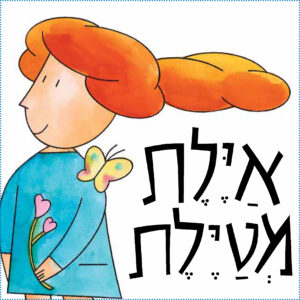 Ayelet’s Day Out
Ayelet’s Day Out 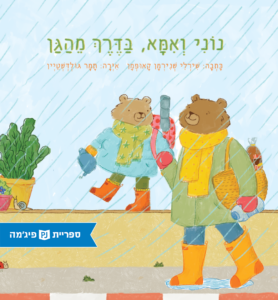 Noni and his Mom Walk Home from Kindergarten
Noni and his Mom Walk Home from Kindergarten 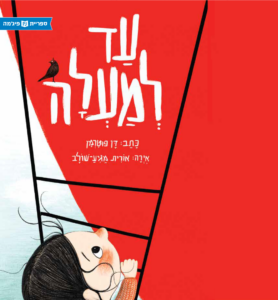 Up and Over
Up and Over 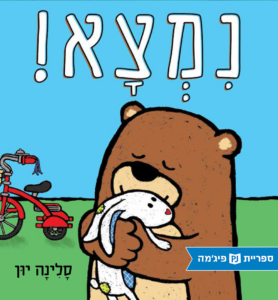 Found
Found 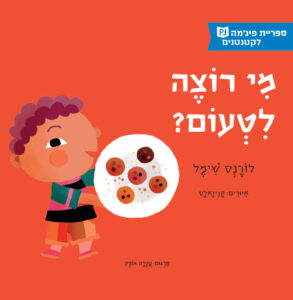 Who wants to taste?
Who wants to taste? 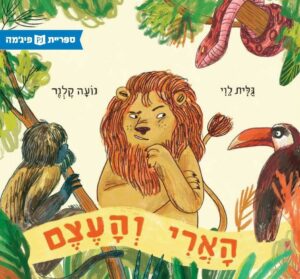 The Lion and the Bone
The Lion and the Bone 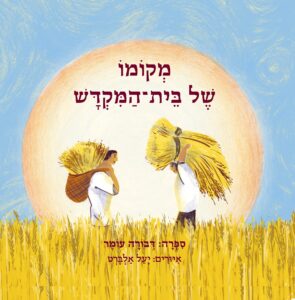 The Site of the Temple
The Site of the Temple 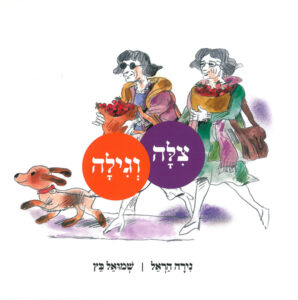 Tsila and Gila
Tsila and Gila 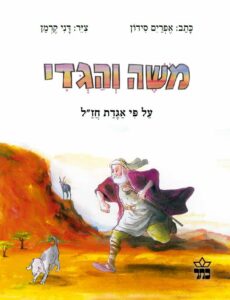 Moses and the Baby Goat
Moses and the Baby Goat 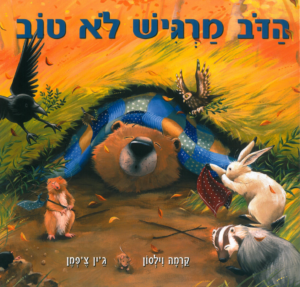 Bear Feels Sick
Bear Feels Sick 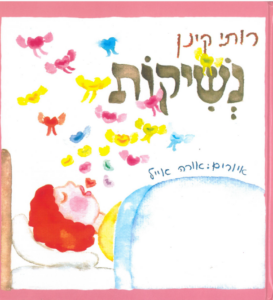 Kisses
Kisses 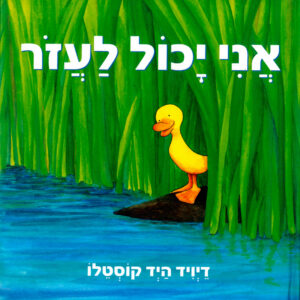 I Can Help
I Can Help 

